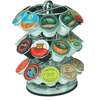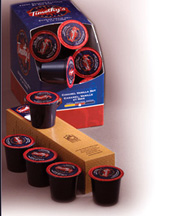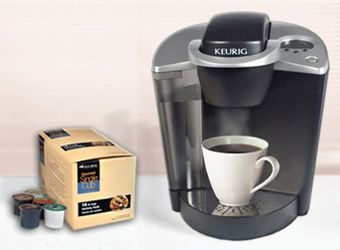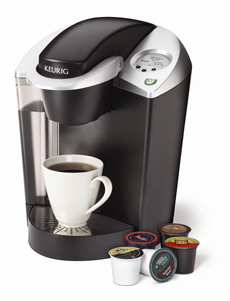Keurig & Tassimo Coffee Makers
Page 4: Detailed Analysis Of Keurig & Tassimo Brewers
This is Page 4 of a six-page article. Click on the links below to visit other pages.
Detailed Analysis Of The Brands
Cost
Each cup of coffee requires a fresh pod; 18 pods are $8.98 (Tassimo) and $9.98 (Keurig). Thus, the cup of coffee produced is 50¢ or 55¢ a cup, without milk and sugar. This is double the cost of buying a pound of very good coffee (there are 40 eight-ounce cups to the pound: $9/lb. coffee equals 23¢/cup, $11/lb. coffee equals 28¢/cup). The Tassimo makes cappuccino and latte using a second pod of shelf-stable milk (“creamer”): 10 pods each of espresso and creamer are $9.98, or $1.00 a cup (more of a bargain given the total ease of production and the cost on the open market).
Taste
The brewed coffees are not of similar quality. Keurig’s offerings are superior.
- Coffee. While we have enjoyed some of Gevalia’s regular coffees from the bag, the coffee produced by the Gevalia pods in the Tassimo machine are just O.K. The regular coffee (Singular Blend) tastes like it has been sitting on the hot plate; the decaf version is a weak brew that also tastes burned. The espresso is “O.K. for Americans” but would never pass muster among true espresso-lovers. The latte and cappuccino creamers make those beverages taste as if they were made with powdered skim milk, and they probably are: the ingredients listed are “part-skim milk, water, sugar, salt, sodium citrate [used for both flavor and as a preservative] and natural flavor”). Using the creamer pods also mandates frequent cleaning of the machine (more about that below). Kraft, producers of Maxwell House, also sells Maxwell House pods for the Tassimo which we did not try (at 18 for $6.49 they are less expensive than the Gevalia); as well as two brands from Europe we did not try, Carte Noire and Kenco. These can be ordered individually or in a continuity plan from the Tassimo.com website.
We far preferred the Keurig system’s Green Mountain and Timothy’s coffees, which taste like the quality coffee we brew at home. Though we don’t use either of those brands, we have previously had their brewed (non-pod) coffee and enjoy it.
- Tea. Tea pods are available, but the tea made in both machines is dreadful. It is a disservice to both the consumer and the tea to make tea in this kind of system. Tea needs to be steeped for several minutes to extract the flavor from the leaves: forcing water through leaves for thirty seconds does not make a palatable brew. The tea we drink daily, Twinings Earl Grey, was unrecognizable and undrinkable when made with a Tassimo pod; similarly, no one wanted to drink the Celestial Seasonings teas made with the Keurig system.
- Cocoa. “Hot chocolate” is available with the Tassimo system. That is a misnomer: it is a Suchard chocolate syrup that, when mixed with water by the machine, turns into something vaguely chocolate-like without any richness or chocolate character. Adding our own milk gave it some body, but did not create any intensity or mask the chocolate syrup taste. Instant cocoa packets from Nestlé or Swiss Miss, mixed with hot water, make a better cup of cocoa.
If the analysis above seems unduly harsh toward the Tassimo beverages, it is because THE NIBBLE is a specialty food magazine reviewing top-quality products for people who understand fine food. Kraft is a company that specializes in mass-marketing supermarket brands to Middle America. There is a clear dividing line between the target markets. However, the Tassimo is not marketed as a Kraft product: it is marketed as a luxury product, at the top of the price scale for single-serve units, and promises to make “the perfect cup.” People who have more refined palates will find that the beverages it produces do not compare favorably with what they are accustomed to. A college kid receiving a gift of one may think it’s the next great invention after the iPod.
Both brands have some plusses and minuses in common:
| Plusses |
Minuses |
- Brewed coffee in a minute or less
- Minimal clean-up*, no mess
- Ease of operation
|
- Cost per serving
- Non-biodegradable plastic waste
- The pods take up a lot of room: 18
pods take almost the space of a box
of 100 tea bags, yet they must
be accommodated adjacent to
the machine (see paragraph below)
- Can’t enjoy the aroma of fresh-
brewed coffee
- Terrible for tea—don’t even
bother
|
*The small pod must be tossed away
 In addition to the footprint for your coffeemaker, you need an adjoining space for the pods. We drink a lot of coffee, switching among six varieties. This meant having the boxes of all the pods sitting on the counter next to the machine—quite an unattractive stack. Keurig sells a cute carousel (at the right) and some industrial-looking racking systems. After you tear off the glossy wrapping of the Tassimo pods, you get two industrial-looking pod carriers. Neither company has figured out what the facial tissue folks have—that you need to make the pod box look very attractive because in many cases, it’s going to be sitting next to their attractive machine in someone’s attractive kitchen. Of course, you can dump your pods into a Baccarat bowl or other fashionable receptacle, but you still need space. In addition to the footprint for your coffeemaker, you need an adjoining space for the pods. We drink a lot of coffee, switching among six varieties. This meant having the boxes of all the pods sitting on the counter next to the machine—quite an unattractive stack. Keurig sells a cute carousel (at the right) and some industrial-looking racking systems. After you tear off the glossy wrapping of the Tassimo pods, you get two industrial-looking pod carriers. Neither company has figured out what the facial tissue folks have—that you need to make the pod box look very attractive because in many cases, it’s going to be sitting next to their attractive machine in someone’s attractive kitchen. Of course, you can dump your pods into a Baccarat bowl or other fashionable receptacle, but you still need space.
 |
 |
 |
 |
A box of 18 pods. Shown, a box of Timothy’s K-cups, or pods, for the Keurig system.
|
|
The pods take up space. During the testing period, we had 6 boxes of pods on the counter at all times: Green Mountain Coffee’s French Roast, Sumatra, French Vanilla, Hazelnut, and two decafs.
|
|
Another point to consider: some advertising has touted the Tassimo as “great for groups.” Hardly! These systems are called single serve for a reason. Unless you’re in a situation where you can’t brew a regular pot of coffee, don’t look at these machines as a solution to making six or eight cups at a time. The charm of making one cup becomes annoyingly repetitive.
Continue To Page 5: Chart Analysis Of Keurig & Tassimo
Go To The Article Index Above
|





 In addition to the footprint for your coffeemaker, you need an adjoining space for the pods. We drink a lot of coffee, switching among six varieties. This meant having the boxes of all the pods sitting on the counter next to the machine—quite an unattractive stack. Keurig sells a cute carousel (at the right) and some industrial-looking
In addition to the footprint for your coffeemaker, you need an adjoining space for the pods. We drink a lot of coffee, switching among six varieties. This meant having the boxes of all the pods sitting on the counter next to the machine—quite an unattractive stack. Keurig sells a cute carousel (at the right) and some industrial-looking 
